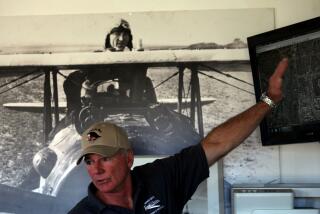Demon of the ‘30s Air Racer
- Share via
It took a few decades for wing nuts to catch up with Bill Turner, champion of the 1930s racing machine.
Turner has been flying on the cutting edge since 1932, when he was a teen and the aviation world was agog over the “Gee Bee,” a monstrously fast light racer built by the Granville brothers (that would be Zantford, Thomas, Robert, Mark and Edward) of Springfield, Mass. During the golden age of air racing in the late 1920s through the 1930s, the sport generated excitement in America and Europe on a par with NASCAR or World Cup events today. At the nadir of the Great Depression, hundreds of thousands watched Jimmy Doolittle set a speed record with the Gee Bee at the National Air Races in Cleveland. At nearly 300 mph, the slight-framed racer was faster than the best military plane anywhere. In the crowd that day was 14-year-old Turner, son of a pioneer Navy pilot. “I got to see all the races. My father was determined to have the Navy take what was being learned and create the fighters we’d need in the future.”
Turner flew in the Navy himself and remained an active pilot. After building his first plane in 1966 (a “Fly Baby” whose top speed was a mere 70 mph), Turner headed back to an era when light planes went a tad faster. His first 1930s replica, of “Miss Los Angeles,” the Brown B-2 racer that placed second in the 1934 Thompson Trophy race, rolled out in 1971. Turner was out front on a trend: By 1998, nearly two dozen replica racers appeared at the Experimental Aircraft Assn.’s annual convention in Oshkosh, Wis.
During the late 1970s, Turner retired as dean of students at Hastings College of the Law in San Francisco, moved to Riverside and opened Repeat Aircraft, a replica and restoration company at Flabob Airport in the Riverside County town of Rubidoux. Turner’s rendition of the Gee Bee Model Z appeared in the 1991 movie “The Rocketeer”; he has also reproduced the American-made Miles & Atwood Special and the British twin-engine de Havilland “Comet,” winner of the 1934 London-Melbourne Race. His most recent endeavor is a Laird-Turner “Special,” which took the Thompson Trophy in 1938 and 1939. Turner has also restored originals such as Benny Howard’s 1930 “Pete.”
The reproductions are so accurate that they’re as dangerous as the originals, which got their preternatural speed from a scary inverse ratio between hefty engine and small frame. Original Gee Bees killed several pilots; Jimmy Doolittle compared flying one to balancing a pencil on your fingertip. Turner nearly became a Gee Bee fatality himself in 1978, when brake failure during a landing whomped Turner and the airplane upside down into a ditch.
Today, the 84-year-old is flight-testing his new Laird and planning his next project. “I’m going to build the French Caudron racer that won the Thompson in 1936. They say it was a real handful.”
More to Read
Sign up for The Wild
We’ll help you find the best places to hike, bike and run, as well as the perfect silent spots for meditation and yoga.
You may occasionally receive promotional content from the Los Angeles Times.






